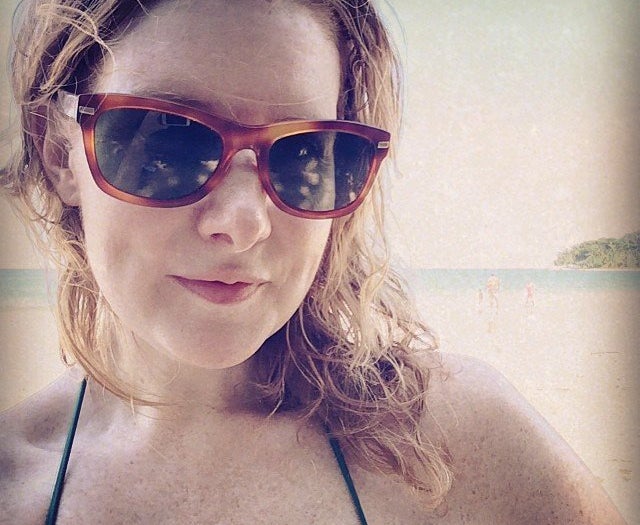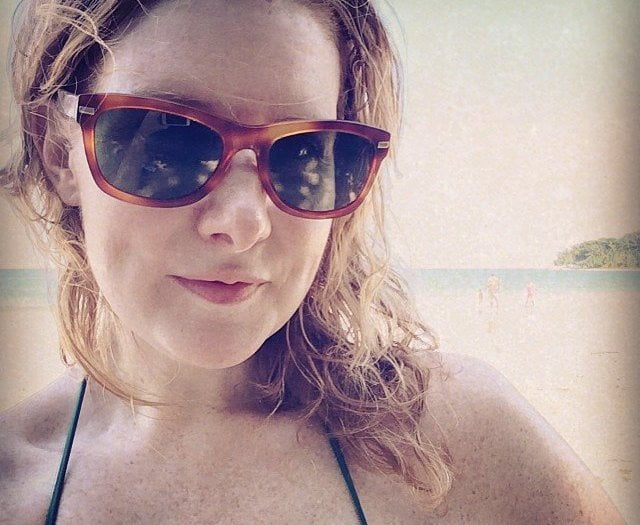
I undressed to my undergarments at my dermatologist’s request. She slowly lifted each arm and examined their undersides. She checked behind my ears, across my stomach, near my bikini area and legs, around my ankles and even on the soles of my feet.
I’d decided to see her for a skin cancer screening as I approached my 30th birthday. She asked me not to wear polish in the future so she could also check my toenails ― no less than Bob Marley was taken down by cancer related to melanoma found on a toe.
For several years, I left our annual visits with good news. Until I noticed a clear, waxy growth at the edge of my hairline after a family beach trip. My mom, who always told me that I could “use a little color” and that “a little tan doesn’t hurt,” thought it was nothing, but my dermatologist knew it on sight.
“Looks like a basal cell.”
Growing up in the rural South, I once relished the oven-like heat that gushed toward me when I opened our front door during the summer months. Most days were spent at my hometown’s one and only pool, but even after withstanding scorching sunburns, my skin maintained its translucent white color, with only an increase in the number of freckles on my arms and, to my great dismay, not a hint of color on my legs.
Working on your tan was like teasing your bangs: You did it because everyone else did it, and you didn’t think much about it. But I, the pale girl who was a bit of an oddball, vaguely knew tanning beds were bad for you and that I was never going to be a cool kid anyway. The comments came nearly every day from classmates who maintained brown legs year-round thanks to the abundance of tanning beds, which overflowed from private homes and coexisted alongside movies at combination tanning bed/video rental stores:
“Hey, Casper!” or “Nice legs, Casper!”
The sound of a clock striking 12, signaling the full force of peak noonday sun, appropriately sends me running for cover.
As summer approached one year and bikinis became de rigueur, the thought of going to the pool with my classmates became too much to bear, so I stopped going. I’d become almost comfortable with my pale outsider status when I heard a classmate announce the highly contested category of Best Tan during senior night.
“Jodie Briggs!”
I begrudgingly accepted the certificate honoring that sweet combo of Scotch-Irish ancestry and teenage bullying. But then, by my early 20s, I began to spend every summer weekend blissfully parked in a lounge chair by an apartment pool.
It’s important to note here that I never skimped on sunblock. I took my applications seriously, always carrying my SPF 50 sunblock with me and religiously following the American Academy of Dermatology’s recommendations to use a shot glass’ worth on my body.
Turns out, thorough sunblock use in your 20s and hiding from the pool during your teens can’t undo years of childhood sun damage. My fair skin, freckles, blue eyes, red hair, moles and family history of skin cancer meant I ticked nearly every box for skin cancer risk.
Basal cell carcinomas (abnormal cancerous growths) are the most common type of skin cancer nationwide. Basal ― and their less-common cousin, squamous ― cell carcinomas are the skin cancers you want to get if you have to get saddled with a skin cancer. They’re slow-growing, generally treatable and almost never fatal.

But no one wants cancer, period. And wasn’t I the best with sunblock? What about those years I hid from my classmates (and my No. 1 frenemy, the sun)? I’d never even used a tanning bed. Years of my life spent avoiding the thing that held the promise of acceptance because it was dangerous, and yet suddenly I was the one with cancer?
I wasn’t alone. Each year in the U.S., 5.4 million new cases of basal and squamous cell carcinomas are diagnosed. And incidences of basal cell cancers in women under 40 have notably risen over the last three decades. I was 34 when diagnosed with mine.
My case may have been much worse had I not avoided those tanning beds; researchers estimate they may be responsible for as many as 400,000 cases of skin cancer each year. And the earlier you start, the more vulnerable you are; those who frequent tanning beds in their teen or young adult years are at higher risk of melanoma, the kind of cancer responsible for the overwhelming majority of skin cancer deaths. Yet these young people ― especially young white women ― are among those most likely to use them.
But, as I learned, simply avoiding tanning beds doesn’t necessarily prevent skin cancer, unfortunately. Just one blistering sunburn in a person’s teen years can nearly double their lifetime melanoma risk. And, lest you believe the myth that this medical problem affects only white people, know that patients with darker skin are also at risk ― and are actually more likely to die of skin cancer since their conditions are often diagnosed later.
My cancer required Mohs surgery. Surgeons removed individual layers of tissue at a time and examined them under a microscope. This way, they removed the cancerous tissue while retaining as much non-cancerous skin as possible. This meant being numbed, having part of my face cut out, then sitting in a busy Manhattan medical office waiting room with a large piece of gauze haphazardly covering my wound while I waited for further instruction.
Years of my life spent avoiding the thing that held the promise of acceptance because it was dangerous, and yet suddenly I was the one with cancer?
Three rounds and four stitches later, I was cancer-free. But I was to forever avoid direct sunlight as much as possible between 10 a.m. and 4 p.m., when UV rays are strongest. This is because individuals who have experienced my kind of cancer are at high risk of recurrence. We also face an increased risk for the more-serious melanoma, incidences of which increased eight-fold among young women from 1970 to 2009 in one study.
I’ve gone four years without additional cancers so far, and the sound of a clock striking 12, signaling the full force of peak noonday sun, appropriately sends me running for cover. The sun’s once friendly, warm hug has become something more sinister. I put extra barriers between us.
On a recent beach trip with my family, an older, leathery man approached as I sat on a blue chair wearing a red bikini.
“You look like the American flag! Red, white and blue!”
Briefly, I turned into the teased young girl of my childhood once again. But I had skin cancer! I thought. I looked around at his companions dotting the crowded beach and realized it wasn’t so bad to be pasty.
Then I adjusted the angle of my beach umbrella.
Source:-.huffingtonpost.
